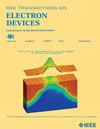基于机器学习的一维声子晶体系链MEMS谐振器锚损降低研究
IF 2.9
2区 工程技术
Q2 ENGINEERING, ELECTRICAL & ELECTRONIC
引用次数: 0
摘要
本文报道了一种基于机器学习(ML)的基于一维葫芦形声子晶体(PnC)系绳的微机电系统(mems)谐振器锚损降低方法。采用前向人工神经网络(ANN)准确预测了PnC系绳的色散特性。然后,根据期望的带隙目标,采用逆神经网络和正向神经网络组成的串联网络预测相应的PnC系绳几何形状。利用串联网络确定了宽展(WE)型压电MEMS谐振器中与期望带隙相对应的PnC系绳的最终最佳几何形状。为了验证所提出的串联网络的可靠性,还通过有限元法(FEM)分析模拟了从ML得到的预测几何形状的色散特性。前向人工神经网络作为一种高速、高精度的计算PnC色散特性的工具,其计算速度比有限元分析快1倍,精度达到99.9%。ML提供了一种可理解且有效的方法,可以使用前向人工神经网络筛选数千个候选设计,并使用串联网络优化PnC设计。本文章由计算机程序翻译,如有差异,请以英文原文为准。
Machine-Learning-Assisted Anchor Loss Reduction of MEMS Resonator With One-Dimensional Phononic Crystal Tether
In this article, a machine learning (ML)-based anchor loss reduction approach for microelectromechanical systems (MEMSs) resonators with 1-D gourd-shaped phononic crystal (PnC) tether is reported here. A forward artificial neural network (ANN) is used to accurately predict the dispersion characteristics of the PnC tether. Then, a tandem network comprising inverse ANN and forward ANN is used to predict the corresponding geometries of PnC tether according to the expected bandgap target. The final optimal geometries of PnC tether corresponding to the desired bandgap, for width-extensional (WE) mode piezoelectric MEMS resonators, are determined with the aid of the tandem network. To verify the reliability of the proposed tandem network, the dispersion characteristics of the predicted geometries obtained from ML are also simulated by finite element method (FEM) analysis. The forward ANN serves as a high-speed and high-accuracy tool for calculating the dispersion characteristics of the PnC, performing calculations ${3} \times {10}^{{4}}$ times faster than FEM analysis, with an accuracy of 99.9%. ML provides an intelligible and effective approach to screen thousands of design candidates with the forward ANN, as well as optimizing the PnC design with the tandem network.
求助全文
通过发布文献求助,成功后即可免费获取论文全文。
去求助
来源期刊

IEEE Transactions on Electron Devices
工程技术-工程:电子与电气
CiteScore
5.80
自引率
16.10%
发文量
937
审稿时长
3.8 months
期刊介绍:
IEEE Transactions on Electron Devices publishes original and significant contributions relating to the theory, modeling, design, performance and reliability of electron and ion integrated circuit devices and interconnects, involving insulators, metals, organic materials, micro-plasmas, semiconductors, quantum-effect structures, vacuum devices, and emerging materials with applications in bioelectronics, biomedical electronics, computation, communications, displays, microelectromechanics, imaging, micro-actuators, nanoelectronics, optoelectronics, photovoltaics, power ICs and micro-sensors. Tutorial and review papers on these subjects are also published and occasional special issues appear to present a collection of papers which treat particular areas in more depth and breadth.
 求助内容:
求助内容: 应助结果提醒方式:
应助结果提醒方式:


